
Stress Getting in the Way of Nutrition? 4 Expert-Approved Strategies to Manage Emotional Eating
Kaitie Yeoman RD, LDN, CDE
Can you believe it’s nearly November??! This year has been bizarre and challenging in so many ways. It seems like every friend, family member, and patient I speak with has their own struggles to bear. And often in the next breath they will tell me they feel relatively fortunate, they’re coping, they’re “fine.” This phrasing usually comes up when we start discussing how they know what they should be doing when it comes to being healthy or achieving their health goals, but they just aren’t doing it. Sound familiar?
These conversations have led to reflection on stress management and emotional health. Ask yourself, have you found yourself turning to food this year? There have certainly been food trends and hobbies aplenty during the COVID19 pandemic and the various stages of lockdown: banana bread, sourdough bread, takeout (takeout, takeout, takeout), etc. These can be enjoyable activities and new hobbies to develop. However, it is important to recognize actions that may be “stress eating” or an “emotional support” type of eating. That is when we eat something because we just want something salty, crunchy, or sweet because we’re feeling some strong emotion. That’s the eating I want to dive into a bit more with you.
In my work as a dietitian, I spend a lot of time considering food and how we eat. People often report times when they find themselves eating despite not being hungry. There are instances where they eat to comfort or soothe themselves, perhaps in response to stress or to distract from strong emotions. These situations are referred to as emotional eating. Perhaps because we eat on a daily basis and we have emotions, it may be difficult to know if this is something you are actually experiencing a problem that really needs solving. Well, friend, as this year has been such a bear, this is definitely an important issue for us to discuss.
It is important not to confuse emotional eating with all emotions experienced with eating or related to food choices. Feeling soothed by chicken noodle soup on a sick day is not emotional eating, nor is feeling guilty after having dessert. Emotional eating is also not reaching for something packaged in the freezer when we are feeling rushed or “breaking” and having pretzels seven hours after lunch and 1 hour before dinner. Food can (and should) taste good and chicken noodle soup is indisputably cozy. Planning our meals and desserts more intentionally is a straight-forward tangle to resolve.
To support the understanding of emotional eating, I want to take this time to dig into behavior and how habits work. We can break habits down into a cycle or loop.[1] There is a cue or trigger, then a routine (the habit in question as a response), followed by a reward. The usual example is brushing your teeth – the trigger is when your teeth feel dirty or the time of your regular bedtime routine, the habit or response is brushing your teeth, and the reward is the feeling of clean teeth and minty fresh breath. Now let’s think about it in terms of food. The American food supply is rich in hyper-palatable foods (overly-tasty) (a recent study found 62% of foods in the USDA database!)[2] – these are items rich in combinations of fat, salt, and carbohydrate or sugar that results in a surge in dopamine (a feel-good neurotransmitter)which is a neurochemical reaction to hyper-palatable foods. These combinations are used in specific amounts by the food industry to increase the tastiness or palatability of foods and to maximize consumption.[3] If we respond to a strong emotional cue with a hyper-palatable food, then the elevated dopamine and short-term feeling of happiness would be the reward. There’s a classic example in television and movies all the time – someone gets dumped, they dig into a pint of ice cream, they feel better (for a short time). It’s easy to see how a pattern of turning to hyper-palatable foods can develop.
By and large, eating in response to emotions is a clear habit loop – we can recognize the cue and response. Emotional eating is very much an addressable pattern: identify the issue or trigger and find alternate responses. Food is a source of fuel and nourishment for the body with a variety of nutrients. Food can also taste good and provide comfort. With emotional eating, there is a tendency to reach for those hyper-palatable “comfort” foods (foods rich in fat and/or high in added sugar like ice cream or pizza) and there is also a tendency to overeat past the point of reasonable nourishment. Enjoying dessert or celebrating with food (ice cream or pizza) isn’t something to demonize or eliminate, however, if a pattern of responding to emotional problems with food is obstructing your healthy lifestyle or progress with goals then it is crucial to address. This pattern of emotional eating as the primary coping mechanism is a frequent contributor to poor health and difficulty with weight management. Keep reading for tips to change your habits and create new patterns.
1. Set Yourself Up for Success
Prevent the problem – implement an eating plan with balanced meals to meet needs and regulate appetite (or schedule periods to check in with appetite)
A good starting place is to create or reinforce the structure in your day. A commonly used Cognitive Behavior Therapy (CBT) strategy is to remove spontaneous decision-making from the equation by having a meal schedule – an outline of when you’ll eat and what you’ll eat ahead of time.[4] A well-balanced eating plan’s goal is to adequately nourish your body by providing appropriate amounts of food and the nutrients needed daily. The Healthy Eating Plate from Harvard School of Public Health is a useful tool for devising high quality, balanced meals that will serve to better regulate the appetite. Eating balanced meals and snacks throughout the day helps to keep blood sugar and energy levels more even. Planning to eat more than one or two times a day also increases the likelihood that we are consuming adequate nutrients consistently.
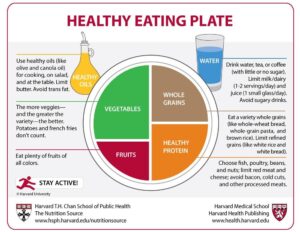
Ultimately, we are less vulnerable to unintentional eating if we feel well-fueled and more satiated. – the same periods of time when we tend to sideline our healthy habits, leaving us extra susceptible to food cravings and unintentional food choices (like the random donuts in the break room or ice cream in the freezer).
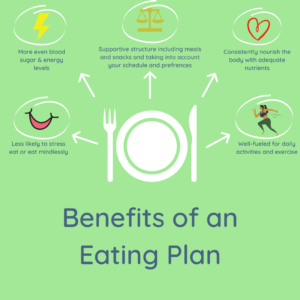
2. Clarify What You’re Feeling
Get familiar with early hunger
People often find themselves in a cycle of making food choices only once they are faced with an insistent, ravenous HUNGER. This can make it a herculean task to maintain an awareness of what is an appropriate amount of food to eat. If this cycle coincides with a period of high stress or other emotional turmoil, a link between feeling strong emotions and responding with food can be created or reinforced. Whether it is a product of stress or a history of dieting (restricting) for weight loss, we often learn to ignore our bodily signs of hunger.
A crucial step in separating your food choices from your emotions is to start paying closer attention. In Intuitive Eating, this is the concept of “Honoring Your Hunger” – recognizing and responding to the biological signal to eat and rebuilding trust in your ability to respond appropriately.[5] Take time to consider what hunger feels like to you. It could be a growling, gurgling stomach, a hollowness, or a headache or light-headedness. Perhaps you feel hunger as decreased concentration or faintness. Examine yourself, your situation – how hungry are you? When is the last time you ate something? The Hunger Scale below provides a straightforward tool to conduct this examination.
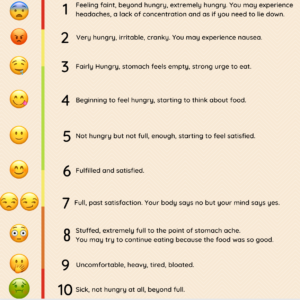
A more structured day and more regular, balanced meals and snacks (Tip 1) will ideally provide you with adequate energy (calories) and nutrients as well as a better-regulated appetite. Checking in with your body and physical signals of hunger and fullness will help you tune into the earlier, more subtle cues that will help you recognize the need to eat before primal hunger rears its head and we find ourselves making panicked decisions. In the next tip, we’ll discuss checking in with your emotions and other feelings that might influence your eating habits and food choices.
3. Emotional Intelligence
Get familiar with your feelings, be a better problem-solver
Before we can solve a problem, we have to do a good job of defining it. If we aren’t finding or diagnosing the correct problem, then we are unlikely to come up with the right answer. Emotional eating is a common occurrence, but many people aren’t aware of the link between their choices and their emotions beyond feeling “good” or “bad” – or “stressed” as an umbrella term. How many of you have treated yourself to dessert or a second glass of wine or the leftover slice of pizza in the fridge because of a “bad” day or being generally “stressed”?
My favorite personal example is how stressed I would get in traffic and working through that. One of the first effective tools I learned about managing stress was to name the feeling. One day I challenged myself to identify the feeling more specifically and ended up stating aloud, to my empty car, “I’m frustrated. I’m so frustrated!” It was a real lightbulb moment – I’m frustrated by traffic and whatever I might have justified to eat or drink once I get home because I ‘deserve’ it afterward wouldn’t actually address the problem of frustration from traffic. Now I find a podcast or audiobook to listen to or give my mom a call to make the wait more enjoyable.
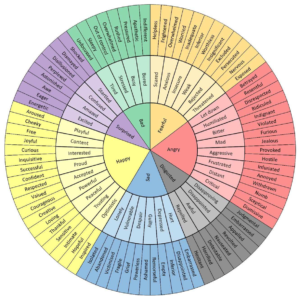
Based on the work of Prof. Robert Plutchik [6]
An Emotions Wheel can be a useful tool in the process of gaining emotional intelligence, highlighting many different feelings that we might be oversimplifying or ignoring. Once you are more specific and aware of what you’re really feeling, you can accurately define the problem. And then the process of finding different responses or more appropriate solutions doesn’t seem so hard. We’ll discuss creating space to do this reflection and problem-solving in Tip 4. You may find that being more familiar with your feelings and emotional health is a good way to prevent problems, much like Tip 1. If you are caring for yourself and regularly “making deposits in your resilience bank account,”[7] you are better able to catch issues sooner and are perhaps less susceptible to every random impulse or food craving.
4. Wait
Separate food choices from emotions
The preceding tips are based on recommendations from the Cognitive Behavior Therapy theory (CBT) and the Intuitive Eating framework. Both of these models also include good discussions and recommendations around food cravings and urges, but here I would like to share a specific practice from the Acceptance and Commitment Therapy (ACT). The ACT model is often paired with mindfulness practices to offer effective intervention for many different types of issues.[8] CBT asks you to identify the thoughts (cognitions) that come before an action (behavior) you want to change, then work to change the thought to see a different outcome. The ACT approach asks you to accept your thoughts and feelings rather than avoiding or rejecting them, then evaluate them with respect to your commitments (or goals and values we are working toward) before taking an action. We have many thoughts and urges every day that we never act on and can build upon that around emotional eating. This works when we develop more willingness or acceptance around our thoughts. To become more aware of what happens before an action, we can use a journal to monitor or track those thoughts and feelings. Once we are aware of patterns (like grabbing a bag of chips when we are stressed or having extra ice cream when we are sad) then we can work on becoming more willing and accepting of those feelings. One way to work on that is with a practice we can call “I’m Having the Thought.” This practice allows you to identify “a thought” and then create space around it, giving you somewhere to sit with it and consider it before moving forward with any action. You might use this time and space to check in with the above Hunger Scale, to examine your eating plan, and determine if it’s time to have one of your previously outlined meals or snacks. You may also recognize that your feeling or need is emotional in nature and not a physical or biological need for food.
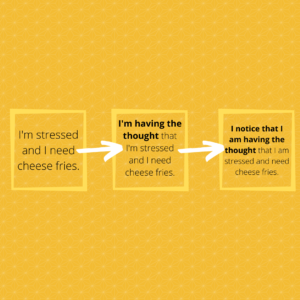
Click here for a 15 minute deep dive into Willingness.
The video above goes into depth on the effectiveness of Willingness with health behaviors and the practice is covered starting at the 10:34 mark.
As you may have noticed in the Emotion wheel above, humans are capable of dozens of emotions. And even in non-2020 years, we are exposed to stressful moments and strong feelings all the time. In my experience, they are regular barriers to our goals so learning to navigate our emotions appropriately will always be worthwhile. I hope you find the above tools and tips helpful as you assess your emotions and eating habits. Whether you are just starting to become aware of these patterns or continue to repair your relationship with food, these are very useful to incorporate.
If you enjoyed and benefited from this information, please like and share it.
Yours in health and wellness,
Kaitie Yeoman, RD, LDN, CDE
Our Dietitians/Nutritionists are here to help you and our office is open. Most major health insurance companies are now covering telehealth visits, usually at no cost to you. Our office will verify your benefits for you – both for existing patients and new patients. What you choose to eat is an essential part of managing your health and wellness. Let us help you to get on track and find a suitable individualized approach to help you to stay healthy.
Click here to contact us for more information.
Illustrations by Ashley Henley*
References
[1] Charles Duhigg The Power of Habit
[2] Obesity (2019) 27, 1761-1768. doi:10.1002/oby.22639
[3] Obesity (2019) 27, 1761-1768. doi:10.1002/oby.22639
[4] https://diet.beckinstitute.org/working-from-home/
[5] https://www.intuitiveeating.org/10-principles-of-intuitive-eating/
[6] https://www.jacquelinehogan.com
[7] Tara Haelle https://elemental.medium.com/your-surge-capacity-is-depleted-it-s-why-you-feel-awful-de285d542f4c
[8] https://positivepsychology.com/act-acceptance-and-commitment-therapy/
Call Us Today: 919-990-1130





